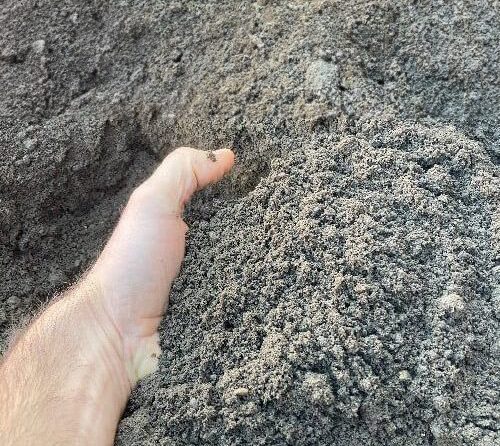- Lawn Turf
- Artificial
- Soil
- Timber
- Composite Decking
- Paving & Stone
Get In Touch With Our Experts Today!
Give us a Call! - Seed & Fertiliser
- Dressing
- Bark

June 10, 2024
Both topsoil and compost are used by gardeners and landscapers alike, so we understand the confusion over the best product to use: topsoil or compost. Both are key ingredients for gardening, and they can help influence the performance, stability, and appearance of your turf, hedges, plants, and flowers. Which one you choose to use really comes down to what you’re trying to achieve. Each has a different structure and qualities, which we’ll explain in the article below.
Topsoil earned its name because it’s the first layer of earth you hit right under your turf and above the bedrock. Topsoil is made up of organic matter, so it’s naturally nutrient-rich and improves the quality of your soil.
What’s great about topsoil is its structure; it can compact and hold its own whilst retaining and adequately draining water. Topsoil is often used in large areas to add depth or level out uneven landscapes. Due to its sturdy structure, it’s also used under turf and when sowing seeds, as it provides a solid substance for the roots to grow.
The Benefits Of Topsoil
The reason so many landscapers use topsoil is because it comes with numerous benefits for your garden, including:
How Can I Buy Topsoil?
If you’re using topsoil, we recommend investing in a high-quality such as George Davies topsoil, which has been thoroughly screened. To figure out how much topsoil you’ll need, start by measuring the areas where topsoil is required. You can then use our topsoil calculator to order enough topsoil to complete your landscaping project.
When we think of compost, we automatically think of the compost bin at the bottom of the garden where you dump all your garden and food waste. It is, but you can purchase compost, too.
Compost consists of a mix of natural materials and decomposed organic matter such as weeds, grass clippings, and food waste – all those things we add to the compost bin! Over time, the contents break down, releasing valuable nutrients to form a compost substance.
It tends to create a softer, drier substance, which makes it easy to handle. Compost is ideal for smaller areas such as potted plants, hanging baskets and boxed flowerbeds. This is because the plants in these environments are enclosed with no access to natural nutrients from the earth. They are often overcrowded and fighting for the available nutrients within their space. By adding compost, plants can feed off its natural goodness.
The Benefits Of Compost
When nurturing plants, vegetables and flowers, compost offers many benefits to help your garden grow, including:
How Do I Make Compost?
The good news is that making your own compost is very easy, and you can start straight away! Invest in a compost bin that you can put in your garden. Place it in a shady spot, ideally directly on top of your soil. As you garden, add any green waste you collect, such as weeds, leaves, grass clippings, moss, etc. You can even add your veg peelings or any food waste.
Composting can take anything from 6 months to two years to mature, especially if you have a large compost bin. Once your compost becomes a dark brown and has a crumbly texture, it’s ready to use. Another tell-tale sign is the damp, woody aroma.
The best time to mix compost with topsoil composting is when freshening flowerbeds or potting plants. By doing this, you combine the organic nutrients of compost with topsoil’s structural and water-retaining features to create a healthy soil product where plants, vegetables and herbs will thrive. Compost can also dry out quite quickly, so mixing it with topsoil will help retain some moisture.
The experts at George Davies have created lots of helpful blog articles on topsoil to ensure you get the most from your product. Take a look at laying turf foundations with topsoil, how much topsoil should I use, and what is the best type of topsoil to answer all your queries.
Or, get in touch with our friendly team who are happy to answer any of your compost or topsoil questions.
CALL US NOW ON 01234 818 253